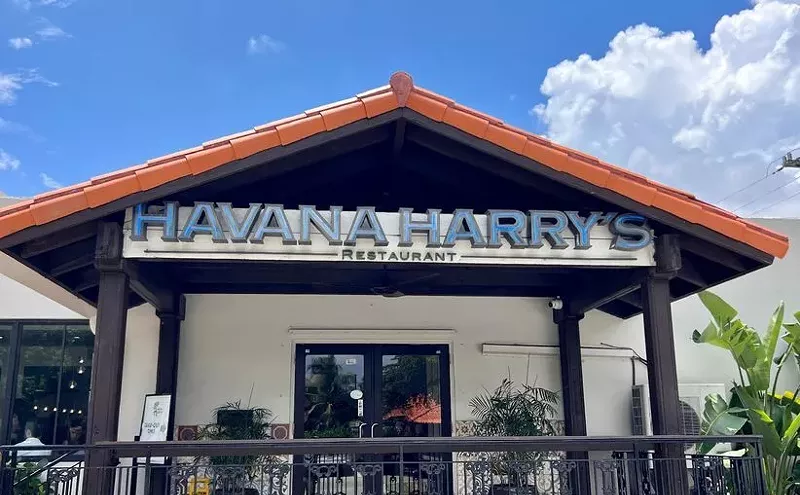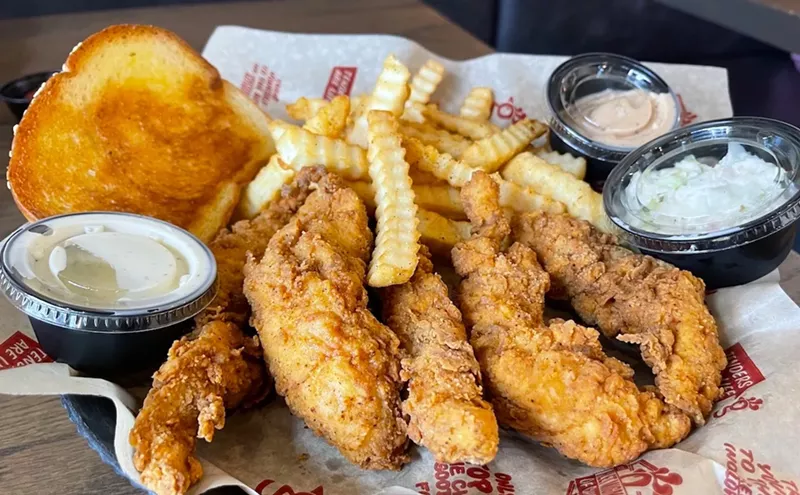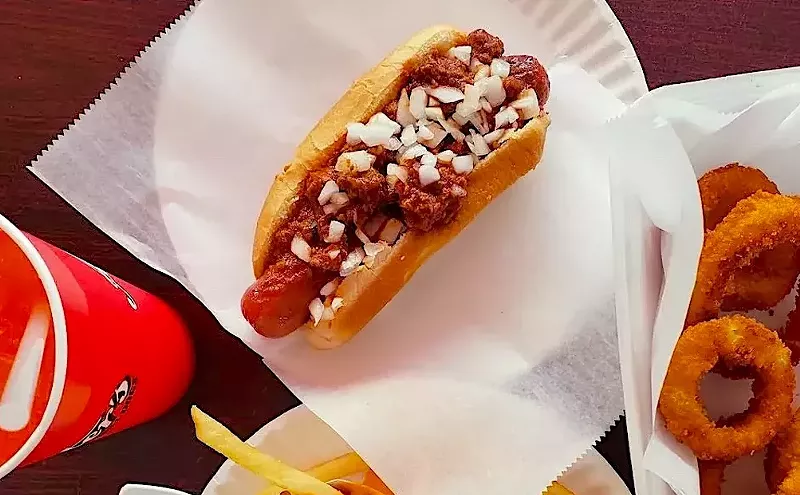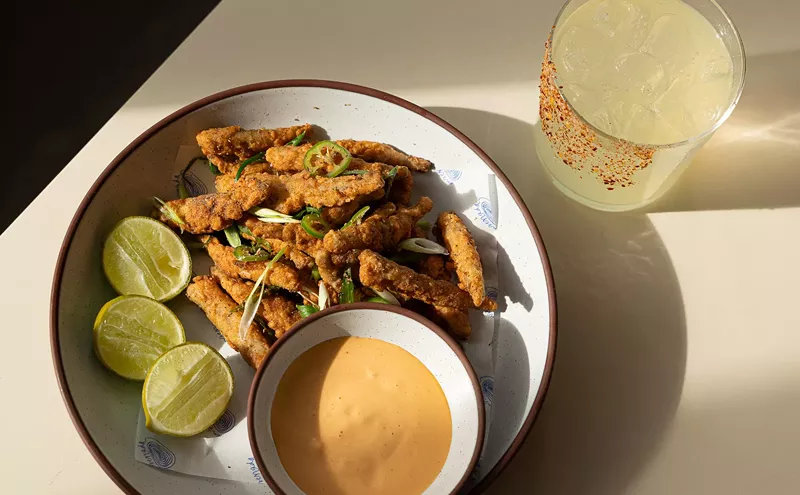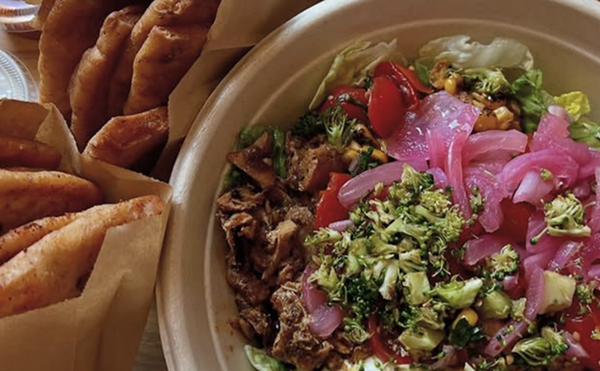It also left me with a clear understanding of why a competitive runner friend invariably chose to do her prerace fueling in Colombian restaurants. ("I'm gonna have that edge," she'd sneer, "from a meal that comes with rice, beans, plantains, potatoes, arepas, black-eyed pea fritters, tamales, another kind of arepas, yuca: starch, starch, and more starch.")
Mapalé is actually a good deal more upscale in style than the average Colombian carbo palace. It's got a lounge rather than luncheonette look (the visuals complemented by a live Latin lounge duo some nights), though the décor is folksy, casual country chic rather than SoBe sleek, and the clientele seems relatively hip -- basically couples out for the night rather than street folks grabbing a bite. The menu lists more salads and nonstarch veggies than usual, too. But if the handpainted wooden menus are indeed, as our server explained, in the style of Fernando Botero, the famed Colombian painter/sculptor whose work is characterized by gargantuan puffed-up people, there is a reason. On both of two visits, my dining companions and I virtually had to be rolled out, despite the fact that we didn't even receive all the dishes we'd ordered due to Miami's usual annoying language problems. (On a second visit, I brought a Spanish speaker, but her Cuban accent seemed to almost terminally confound our very nice but not very efficient server.) At any rate, those with road races to run after dinner will not find their bods lacking in burnable carbs.
To start there is a starch sampler. Okay, sorry; it's called the Mapalé Sampler, and it actually didn't have as many starches as advertised. Cornmeal fritters -- a.k.a. arepas -- were on the menu but, disappointingly, not on the platter. To compensate, there was an overload of patacones, which may sound uniquely Colombian but are nothing but lots bigger -- and, if Mapalé's are typical, tougher -- tostones: sort of saucer-sized circles of deep-fried packing carton. There was also a Colombian-style empanada, a thimbleful of meat-and-filler filling enclosed by an astonishingly thick, doughy crust. Rounding off the platter was a small bit of protein substance, a loose-textured little sausage that was not bad but not nearly as spiced or as juicy as any number of Argentine parillada sausages available twenty blocks south in Little Buenos Aires.
Having heard Mapalé's Cartagena;a shrimp cocktail touted, by an alleged food professional, as a ceviche, I was disappointed in the presentation of five rather overcooked medium-size shrimp bathed in that sweetish mayo-based pink stuff, similar to Thousand Island dressing, that so many Latin American countries' cuisines feature on everything from salad to pizza. Cilantro and a little diced onion helped cut the blandness, but the horseradish supposedly in the sauce was undiscernible. What were, oddly, scattered throughout the dressing were tiny salad-size shrimp that were dry as dust; I'd diagnose a severe case of freezer burn.
The Tayrona salad was much better. Dotted with satisfyingly sinful deep-fried yuca croutons, the pile of romaine lettuce was dressed with a guanabana-citrus emulsion that looked alarmingly like pink stuff, just slightly fruity-sweet with a much lighter texture.
By far the best starter, in fact outstanding, was ajiaco. This chicken, potato, and corn soup is a Colombian specialty rarely made well outside that country since its signature herb, guascas, is hard to find in most U.S. markets -- for good ecological reasons, actually; the herb's also known as quickweed because it's so invasive that its seed starts germinating before it hits the ground. So by the time this review's published it may be necessary to hack your way into Mapalé with a machete, but this soup alone is worth the trouble. Creamy but not at all gloppy, hearty enough to be a budget whole meal but not heavy, and infused with unimaginably luscious essence-of-chicken flavor. Also a soup of sorts but less successful, and more expensive, was cazuela de mariscos. I'm sure the broth was homemade, but it had the sticky-thick cornstarchy constitution of canned condensed shrimp bisque, and the conch bits that were the main seafood component were shoe leather.
Aborrajado (described as sweet plantain with guava paste, figs, papaya, and melted mozzarella) sounded interesting but was unavailable due, our server said, to lack of sweet plantains. However, "Colombian style" paella momposina, supposedly served with green plantains, came with a big side of the ripe ones. Go figure. And while you're at it, try to figure out what Colombian-style paella means; except for totally lacking in Spanish-style paella's saffron, and with a very large proportion of rice to tiny, not very fresh-tasting seafood morsels, I couldn't come up with an answer.
Santa Marta red snapper, a whole fish recommended strongly by our server, had been deep-fried so long that the petrified specimen was more suited to mounting on the wall than eating. Not even the promised "sautéed garden of vegetables" could've helped, had they come, which they didn't. What accompanied the fish was a lot of the aforementioned patacones, which in fact accompanied everything except dessert, plus a heap of coconut rice. The latter starch was tasty.
On both visits, though, the kitchen surprised my table just as we were getting real grouchy. Mapalé fish was wonderful, a small but perfectly cooked juicy grouper steak in an elegant, light coconut milk-enriched Creole sauce. But Catalina grilled chicken was the real surprise; given how easy it is to grill skinless white meat chicken bone-dry, I cannot even remember the last time I ate a truly moist butterflied breast. But Mapalé's was both ultrajuicy and full of scrumptious wood-smoke flavor. The chicken came accompanied by unheralded crisp garden vegetables, but no need for runners to panic; there were yuca, patacones, and a heap of rice, too.
For dessert, passion fruit mousse had a nice tang, but athletes wanting a more perfectly balanced all-carb meal should go for flan, more of a cornstarch-thickened pudding than the usual custard. To drink, the house special is a mix of super-sweet Colombian soda and beer. Are we hopped up yet? But prices are moderate, so no need to worry if you win the race for the check.



